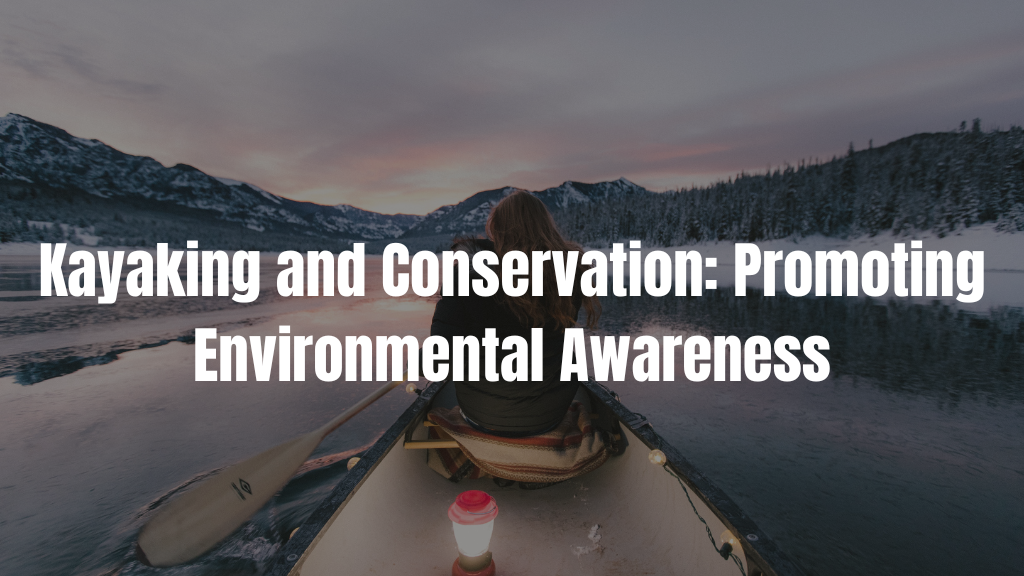Kayaking is not just an exhilarating outdoor activity; it also holds the potential to be a powerful tool for promoting environmental awareness and conservation efforts. As kayakers navigate serene waterways and explore the beauty of nature up close, they become intimately connected with their surroundings, making them natural advocates for protecting our fragile ecosystems. In this article, we’ll delve into the synergy between kayaking and conservation, highlighting how this sport can raise environmental consciousness and provide unique opportunities for education. Let’s paddle our way through the waters of kayaking’s role in fostering a deeper appreciation for nature.
The tranquil waters of rivers, lakes, and oceans have long beckoned adventure seekers, offering them an escape from the hustle and bustle of daily life. Kayaking, a water-based sport that involves paddling through these serene landscapes, has gained immense popularity in recent years. However, its significance goes beyond just leisure and physical activity; it can serve as a potent catalyst for fostering environmental consciousness.
The Connection Between Kayaking and Conservation
At its core, kayaking is about more than gliding over water; it’s about immersing oneself in the natural world. As kayakers dip their paddles into the water, they become part of a delicate ecosystem that sustains an array of aquatic and terrestrial life forms. This connection prompts kayakers to develop a profound appreciation for the beauty and vulnerability of these environments.
Benefits of Kayaking in Promoting Environmental Awareness
Physical Engagement with Nature
Unlike traditional watercraft, Kayaks Offer a more intimate experience with the environment. The close proximity to the water’s surface allows kayakers to observe aquatic life, water clarity, and the ecosystem’s intricate dynamics.
Witnessing Biodiversity
Kayaking provides a front-row seat to the diverse array of plants and animals that depend on aquatic habitats. From vibrant fish to elegant waterfowl, kayakers often witness the biodiversity that thrives beneath the water’s reflective surface.
Experiencing Fragility
The peacefulness of kayaking contrasts with the vulnerability of ecosystems. Eroding coastlines, diminishing fish populations, and pollution remind kayakers of the urgent need to protect and preserve these habitats.
Challenges and Threats to Natural Waterways
While kayaking offers a unique perspective on the natural world, it also exposes the detrimental impact of human activities on water bodies.
Pollution and Plastic Waste
Plastic pollution poses a severe threat to aquatic ecosystems. Kayakers frequently encounter plastic debris along their routes, serving as a stark reminder of the need to reduce single-use plastics.
Habitat Destruction
Urbanisation and development often encroach upon vital wetlands and shorelines, disrupting critical habitats for aquatic life. Kayakers can witness firsthand the consequences of habitat destruction.
Invasive Species
Kayakers may inadvertently contribute to the spread of invasive species by transporting them on equipment. This underscores the importance of cleaning equipment thoroughly between water bodies.
Conservation Initiatives within the Kayaking Community
The kayaking community has not remained silent in the face of these challenges. It has emerged as a passionate advocate for the protection of natural waterways.
River and Coastal Cleanup
Kayakers frequently organise cleanup events, where they paddle along water bodies, removing debris and waste. These efforts not only restore the beauty of the environment but also inspire others to take action.
Advocacy for Clean Water Regulations
Kayakers leverage their unique vantage point to advocate for stricter regulations on water quality and pollution control. Their firsthand experiences provide valuable insights for policymakers.
Educational Workshops
Many kayaking clubs and organisations host workshops to educate paddlers about environmental conservation. These workshops cover topics such as local ecosystems, pollution prevention, and sustainable paddling practices.
Kayaking as a Tool for Environmental Education
Beyond its direct conservation efforts, kayaking holds immense potential as an educational tool.
Hands-On Learning
Kayaking provides hands-on experiences that textbooks can’t replicate. It engages the senses and fosters a deeper understanding of aquatic ecosystems and their intricacies.
Igniting Curiosity in Ecology
The sights and sounds of nature experienced during kayaking trips spark curiosity. This curiosity, in turn, drives individuals to learn more about the ecosystems they encounter.
Fostering a Sense of Responsibility
Kayakers often develop a sense of responsibility for the environments they explore. This sense of ownership fuels their commitment to preserving these areas for future generations.
Building a Conservation Mindset: Tips for Kayakers
Kayakers can further amplify their impact by adopting conservation-focused practices.
Leave No Trace Principles
Adhering to “Leave No Trace” principles ensures that kayakers minimise their impact on natural areas. This involves packing out all trash, avoiding damage to vegetation, and respecting wildlife.
Sustainable Paddling Practices
Kayakers can reduce their environmental footprint by using eco-friendly products and supporting brands committed to sustainability. Additionally, practising proper kayak storage and maintenance prevents fuel and chemical leaks.
Spreading Awareness Through Social Media
Social media platforms offer kayakers a powerful tool to share their experiences and insights. By showcasing the beauty of the environment, they can inspire others to take an interest in conservation.
FAQs (Frequently Asked Questions)
- Is kayaking suitable for all age groups?
Absolutely! Kayaking is a versatile sport suitable for people of various age groups. Many kayaking centers Offer Different Kayaking options, from calm lake paddling to more adventurous whitewater experiences. - How can I contribute to river cleanups?
Participating in organised river cleanup events is a fantastic way to contribute. Keep an eye out for local kayaking clubs or environmental organisations hosting such activities. - What safety measures should I take while kayaking?
Safety is paramount. Always wear a properly fitted life jacket, familiarize yourself with the water body’s conditions, and inform someone about your kayaking plans before heading out. - Can kayaking help me learn about local ecosystems?
Absolutely! Kayaking provides an up-close encounter with local ecosystems, allowing you to observe wildlife, vegetation, and water quality. It’s a unique way to learn about the environment. - What are some recommended kayaking destinations for conservation enthusiasts?
Destinations like national parks, wildlife sanctuaries, and protected waterways offer excellent opportunities for kayakers to engage with nature and contribute to conservation efforts.
In conclusion, kayaking serves as a bridge between recreation and conservation. Its immersive nature kindles a passion for protecting our natural heritage. By blending adventure with environmental awareness, kayakers are not only exploring waterways but also fostering a sense of responsibility towards our planet’s delicate ecosystems. As we navigate these waters, let’s remember that every stroke of the paddle can create ripples of positive change.




